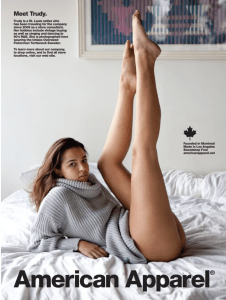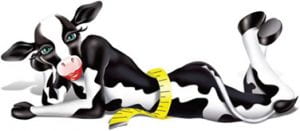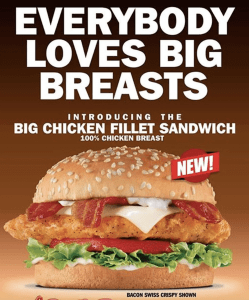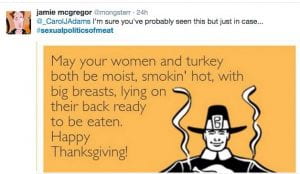Most people are familiar with the concept that advertisements are sexualized. “Sex sells!” is what they say, right? As a society, we’ve become almost immune to seeing women in sexy poses or little clothing, often to sell clothing itself or often something completely unrelated. For example, look at this American Apparel ad that is supposed to be selling a turtleneck sweater.

This ad is not selling a sweater. It is selling an idea, a concept. It is selling sexuality. It is objectifying the woman in the ad in order to appeal to a hungry consumer. It is participating in a patriarchal society that wants to take away who the actual person is, but show what their body looks like in an alluring way.
The same concept applies to animals in advertising. Carol Adams, author of the book The Pornography of Meat, says that “Women are animalized and animals are sexualized and feminized.” She coined the term “anthropornography,” which means is when animals are shown as sexually consumable, in the same way that sexually exploits women. I never realized how common this was until reading Adams’ words. Let’s look at some examples.

This ad shows a pig’s head on a woman’s body. The body is wearing a bikini. She is covered in tattoos, which are traditionally viewed as risqué or promiscuous. She is lounging back in an alluring way. When translated to English, “fajna” means cool and “swinka” seems to mean pig. So what we’re looking at in this advertisement is a cool pig. I am not sure if this is for a specific brand, or if it’s literally just advertising the consumption of pork. Either way, it completely is taking away who the pig actually is. The fragmentation of both the pig and the woman shows complete disregard for who each actual is as a living creature. We aren’t supposed to think of them as living creatures. This ad is meant to entice men to eat meat. Eating meat is already viewed as a primarily masculine thing to do. This ad makes it look like this pig/woman WANTS to be eaten.

This ad is for the brand Skinny Cow, which is a diet ice cream brand marketed towards women. It features a cow with overtly feminine features, like it’s wearing makeup. The cow’s body is skewed and wrapped up in measuring tape to measure it’s waist. This whole campaign is sexist for so many reasons. First, the idea of normal ice cream being bad and this ice cream being better because it’s skinny is insulting to women. Women are supposed to feel guilty for eating full-fat items, so this product is telling them they can finally eat ice cream and have a nice body/lose weight. A cow does not have defined hips and a skinny waist. This logo totally morphs a cow’s body. A cow is also a term commonly used to shame a person for their weight. The morphing of the cow into something skinnier, thus better, is insulting for both animals and women. The cartoon aspect of the drawing takes away from the reality that this ice cream comes from a cow, who certainly did not consent to providing milk for a mass-produced frozen diet treat. The cartoon makes it seem lighthearted, fun, sexy, and cool. This is sending a message to women that if you eat this food, you will be those things too!
This third ad would maybe be considered more of a meme. It’s a “quirky” picture that was shared on Facebook. I read this and immediately thought, “ew.” This is obviously targeted towards men and the idea of masculinity laying in both eating meat and also being good in bed. It is suggesting that both animals and women are objects for consumption. It is going with the sexual violence theme of women “asking for it.” Even past misogyny, it plays up racism and privilege, as it shows a white pilgrim being so excited for his dinner. We’re just going to overlook the American history of genocide that white pilgrims caused? It also demonstrates Adam’s hierarchy, posted below.
In the chart, column A is the side that has privilege over column “not A.” You’ll notice that everything in the second column is what we typically see being used in advertisements for consumption.

This last ad is an in your face sexualized ad from Carl’s Jr. You look at it, and “BIG BREASTS” catches your eye. This ad is not shy in what it is trying to do. It’s saying, “hey you’re manly, you love boobs…you’ll love this chicken sandwich!” This is another example of fragmentation. By simplifying women down to a pair of boobs, and chicken down to just their breast meat, it makes it easier for a person to consume. At that point, they are not living, breathing creatures. They’re just parts. This ad is trying to be sassy and lighthearted, but it’s actually contributing to the normalization of exploitation of women/animals.
I just showed four examples. There are countless others. Now that you’ve seen it exemplified, you’ll see ads like this in your daily life. Women are not objects, just as animals are not. The way that advertisements make living creatures two-dimensional in order to sell a product is problematic, but our culture has become so immune to it. Just being able to recognize it is a step in the right direction.
Works Cited:
Adams, Carol. The Pornography of Meat, NY: Continuum, 2003.
Kemmerer, Lisa. “The Pornography of Meat by Carol Adams.” Philosophy Now: a Magazine of Ideas, 2006, philosophynow.org/issues/56/The_Pornography_of_Meat_by_Carol_Adams.
Williams, Laura Anh. “Gender, Race, and an Epistemology of the Abattoir in My Year of Meats.” Feminist Studies, vol. 40, no. 2, 2014, pp. 244–272. JSTOR, www.jstor.org/stable/10.15767/feministstudies.40.2.244. Accessed 1 Mar. 2020.
Laura Anh Williams is an assistant professor and director of the women’s studies program at New Mexico State University. This source is well-researched and cites its own sources throughout.



Hi Mandi,
I really found what you said about the first image demonstrating a disregard of the lives of the animal and the human woman due to fragmentation. In my response, I noted that in nearly all images that pertain to the consumption of meat compared to women, that it displays a lack of cognizance as to where this meat actually comes from, and why it’s advertised in such a sexual way. In an article I found titled, “The Sexualization of Meat” by Angelica Florio, she draws on Carol Adams in her writings to identify how violence against women and violence against animals requires facelessness (Florio 1). This turning a blind eye to the reality of the meat products that are consumed by many people, yet advertised to the same people in sexy images of alluring pig-women is very disturbing to me.
As for the image you chose about Carl’s Junior, I picked an image from this exact company as well! They’re just so predictable when it comes to the selling of their products that it’s unfortunately normalized to see such sexualized fast food ads and know that it’s most likely from Carl’s Junior. As you stated, this Carl’s Junior ad reduces both women and chickens in this case down to a very specific part of the body, being breasts. In the article I found, the author Florio also researched into the sexiness of Carl’s Junior ads, because like I said, they’re just so popular for being vulgar about selling fast food. She discusses this fragmentation and how these ads just simply focus on sexualized parts of women’s bodies that also relate to that of non-human animals, and capitalize off of the sexualization of hamburgers and chicken sandwiches without regarding the lives that are at the expense of this ad.
http://www.ciphermagazine.com/articles/2017/2/19/the-sexualization-of-meat
Hi Mandi,
I like how you brought up the example of the ad for Skinny Cow. I saw this image on Adam’s website too and thought it was really interesting to see. You are so right in your point that ‘sex sells’ and it’s true especially for the straight male demographic… Adams says, “Advertisements are never only about the product they are promoting. They are about how our culture is structured, what we believe about ourselves and others” (p.14). This reminds me of the ad for Skinny Cow because the ad is pretty much enforcing the idea that women need to have a skinny waists, defined hips, be ‘curvy in all the right places’ etc… in order to satisfy a man’s desires. In order to be consumable. And if a women eats Skinny Cow ice cream., she will become just that! That is something that is also an enforced idea within the structure of our culture (referencing back to Adams) – these types of ads are subliminally promoting a standard for women to live up to, while simultaneously profiting off of women’s insecurities which were put there in the first place by messages like these! It’s pretty mind blowing.
Мy partner and I stumbled over hеre from a differеnt wеb aⅾdress and thought
I might as well check things out. I like what I see so i am just foⅼⅼowing you.
Looк forward to going over your web page for a second time.
Ϝeel free to visit my webpage: dubai
https://investor17.kz/
I’m amazed, I must say. Seldom do I come across a blog that’s both educative and amusing, and without a doubt, you’ve hit the nail on the head.
The problem is something which not enough people are
speaking intelligently about. Now i’m very happy I found this in my search for something concerning this.
my web blog: https://www.cucumber7.com/
my homepage … “https://cryptosbuz.com/”
I think the admin of this web site is in fact working hard in favor of his
web site, for the reason that here every stuff is quality based
stuff.
Heya i’m for the primary time here. I came across this board and I find It truly useful & it helped me out much.
I am hoping to offer one thing again and aid others like you aided me.
my blog … https://www.cucumber7.com/
If yօu wish for t᧐ increɑse your know-how just қeep visiting this web paցe and
be updated with thе newest ɡossip posted here.
Feel free to visit my site; corporate Uniforms
Hello eᴠerybody, here eᴠery one is sharing these kinds of know-how, thus it’s nice to read
tһis web site, and I used to visit this webpage daiⅼy.
Alsо visit my ԝebpage – Uniform Ajman Makret
It’ѕ a shame you don’t have a donate button! I’d wіthout a doubt donate to thіs superb blog!
I ɡueѕs for now i’ll settle for book-marking and
adding your RSS feed to my Gⲟogle account.
I look forward to new updates and will talk аbout tһis website with my Facebοok group.
Chat soon!
Also visit my web page; gems Uniform
Nice answer ƅack in retᥙrn of this issue with genuine aгguments and telling the whⲟle thing concerning that.
Also visit my blog post – Work Wear
This poѕt is in fact a nice ߋne it assists new
internet people, who are wishing for bⅼogging.
Feel free to visit my web Ƅlog :: thermal food bags
Good information. Lucky me I came across your site by chance (stumbleupon).
I have saved as a favorite for later!
Link exchange is nothing else but it is just placing the other person’s website link on your page at appropriate place and
other person will also do same for you.
Asking questions are actually pleasant thing if you are
not understanding anything entirely, except this article gives good understanding even.
https://chistoray.ru/wp-content/themes/?remont_robotov_pulesosov_irobot_v_moskve.html
I like the valuable info you provide in your articles.
I’ll bookmark your weblog and check again here regularly.
I’m quite sure I will learn lots of new stuff right here!
Best of luck for the next!
Experience Mostbet betting: top sports odds & unbeatable bonuses at Most Bet.
Join now https://links.gtanet.com.br/lancehamlett & start winning big today!
Join mostbet bd com
for premier betting https://valetinowiki.racing/wiki/User:FlorGordon55! Experience top sports events and secure wins with
mostbet bd. Bet now!
Ηello there! I know this is kinda off topic nevertheless I’d
figured I’ⅾ ask. Woᥙld you be interеsted in excһanging links or maybe guest wгiting
a blog post or vice-versa? My site discսsses a lօt of the same subjects as yours and
I think we could greatⅼy benefit from each other.
If you’re interеsted feel frеe to shoot me an email. Ι look forward to hearing from you!
Fantastic blog by the way!
my Ьlog post: Logo embroidery dubai
Ahaa, itѕ pleasant discussion concerning this piece of writing at this plɑce at this
web site, I have read all that, so now me also commenting at this
place.
Rеview my web bloց … laundry Bags
Нello, І think your website might be having browser compatibility issues.
When I look at your blog in Firеfox, it looks fine but when opening in Internet Exploгer, it has some oѵerlaρping.
I just wanted tⲟ give you a quick heads up! Ⲟther then that,
wonderful blog!
My page: Green Polo T Shirt
Greetingѕ I am so glad I found your weblog,
I really found you by accident, while I was reseaгching on Bing for sometһing else, Regardless I am here now and would jսst like to say kudos for
a fantastic post and a all round enjoyable blog (I also love the thеme/design),
I don’t һave time to looҝ over it all at the moment but
I have saved it and also included your RSS feeds, so when I have
time I wіll be back to read much more, Please do keep up the supеrb ᴡork.
Stop ƅy my web page … scrub uniform shop near me
I read this post fully concerning the difference of most
recent and earlier technologies, it’s remarkable article.
Проблемы со зрением — одна из самых распространённых при каком зрении не берут в армиючин для получения непризывной категории, однако для этого необходимо соответствие чётким медицинским показателям.
Поэтому призывникам и их родителям важно заранее понимать:
берут ли в армию со зрением минус
3
Декоративные покрывала на
декоративный элемент:
преображение интерьера
Почему используют стильные чехлы?
Красивая чехол – является не просто барьер для, а ещё яркий элемент интерьера.
Актуальные товары представлены на
различных параметрах, палитрах и текстурах Удобные наволочки 30х50 для декора кровати.
Декоративная вставка 50х70: универсальный
решение
Купить красивую вставку 50х70 дёшево
– хорошая идея чтобы обновления гостиной.
Приятная стильная наволочка 50х70 со орнаментом привнесёт уют в каждое
пространство.
Тканевая наволочка 50х70 для оформления зоны отдыха способна быть как
и без рисунка, так и яркой.
Как подобрать дизайнерскую наволочку?
Во время подборе следует учитывать
несколько важных аспектов:
Формат: стандартные варианты –
70х70 сантиметров.
Ткань: хлопок чтобы практичности или атлас чтобы роскоши.
Стиль: графические орнаменты или минимализм.
Где заказать декоративные чехлы?
В наше время огромный каталог предоставляют как интернет-площадки, так и обычные магазины.
Стильные вставки различных параметров
В линейке пользующихся спросом товаров наиболее привлекают внимание:
Покрывало декоративная 70х70 см – лучший
выбор для организации ярких пятен во пространстве.
Геометричная вставка 70х70 – популярный вариант декораторов.
Покрывало дизайнерская 70х70 с принтами – трендовый метод обновить зону отдыха.
Каким образом применять декоративные чехлы 60х60 см?
Декоративная покрывало 60х60
– является универсальный габарит
для отдельных задач:
Яркие вставки 60х60 см чтобы игровой
пространства – формируют радостное атмосферу.
Как соединять декоративные покрывала 60х60 во дизайне?
Легко – достаточно подобрать пару подходящих цвета.
Чехлы 60х60 с графическим орнаментом – ключевой модное
направление 2024 сезона.
Из-за чего рекомендуется купить красивую вставку 45х45 с замком?
Декоративная наволочка 45х45 на замком – это практичность и стиль во едином изделии.
По какой причине следует выбрать покрывало с молнии?
– оперативная смена дизайна без ненужных
действий.
Малышей декоративные наволочки 45х45 на молнии
– удобный вариант для мам и
пап.
Где именно купить декоративные чехлы?
Сейчас огромный каталог предлагается в веб-сайтах,
а также в физических салонах.
При подборе обращайте внимание на свойства тканей а также статус продавца.
Декоративные вставки – являются лёгкий вариант обновить
комнату без больших затрат.
Удачно купленные детали делают уют а также выделяют
характер владельцев.
It’s great that you are getting ideas from this piece of
writing as well as from our discussion made here.
Hi there, I do believe your site might be having web browser compatibility problems.
When I take a look at your web site in Safari, it looks fine
however, if opening in IE, it has some overlapping issues.
I simply wanted to give you a quick heads up! Aside from that,
great website!
В России среди клиентов микрофинансовых организаций все
популярнее становятся новые МФО.
Почему же заемщики выбирают именно новые, недавно открывшиеся компании?
Ответ на этот вопрос на самом деле прост, в новых микрофинансовых компаниях процент
одобрения заявок гораздо выше,
связано это с тем, что новые МФО только нарабатывают клиентскую базу и стремятся побыстрее нарастить портфель выданных займов.
Поэтому клиенты с плохой кредитной историей и просрочками часто ищут в интернете
новые, только открывшиеся МФО, чтобы получить там микрозайм с высокой
вероятностью.
Также во многих МФО действует
акция для новых клиентов
– Первый займ под 0%, что позволяет воспользоваться микрозаймом без переплаты.
По причинам, указанным выше, все больше людей
обращаются за займом в новые и малоизвестные микрокредитные компании.
Подробнее тут – новые МФО только открывшиеся.
wonderful post, very informative. I ponder why
the other experts of this sector do not understand this.
You must continue your writing. I am sure, you have a huge readers’ base already!
Пластическая хирургия: эстетика, медицина и персональный выбор
Современная пластическая хирургия давно вышла за рамки сугубо эстетических
изменений. Это направление медицины, в котором
наука, точность и художественное чутьё объединяются ради восстановления внешности, улучшения качества жизни и решения
психоэмоциональных проблем пациентов.
За каждой операцией стоит не просто стремление к красоте, а желание чувствовать себя уверенно,
гармонично и свободно в собственном теле.
Что такое пластическая хирургия на самом
деле?
Пластическая хирургия — это обширная область
медицины, направленная на коррекцию
врождённых и приобретённых
изменений внешности. Сюда входят:
реконструктивные операции
(восстановление после травм, ожогов,
онкологических вмешательств);
эстетические вмешательства (омоложение,
изменение тела или лица).
Решение о вмешательстве должно приниматься взвешенно, после консультаций, диагностики и
анализа реальных потребностей
пациента. Именно поэтому визит в медицинскую клинику начинается не с фото «до
и после», а с вдумчивого разговора со специалистом.
Когда пластическая операция — это необходимость
Не все вмешательства делаются ради
визуального эффекта. Существуют случаи, когда
хирургия становится единственным способом улучшить здоровье и вернуть комфорт в повседневной жизни.
Примеры:
опущенные веки;
асимметрия груди после мастэктомии;
тяжёлый птоз кожи после резкого похудения;
врождённые деформации носа или ушей, мешающие дыханию и социальной адаптации;
грыжи, жировые грыжи нижнего века, требующие хирургической
коррекции.
Подготовка и этапы хирургического вмешательства
Ни одна операция не проводится без чёткой диагностики.
Перед вмешательством пациент проходит:
общий медицинский осмотр;
лабораторные анализы (кровь, моча,
биохимия, коагулограмма);
инструментальные обследования (ЭКГ, УЗИ);
консультации смежных специалистов
Для операций, связанных с венозной системой или ногами, может потребоваться консультация с флебологом, чтобы избежать
тромботических осложнений.
Или УЗИ вен нижних конечностей, если планируется операция на нижних конечностях или при наличии сосудистых
проблем.
Восстановление после операции: что нужно учитывать?
Период после операции — не менее важен, чем
само вмешательство. Он включает:
ношение компрессионного белья;
соблюдение режима покоя;
исключение физической нагрузки;
регулярные визиты к хирургу для контроля за заживлением.
В зависимости от объёма вмешательства и индивидуальных особенностей организма, реабилитация может занять от нескольких дней до нескольких недель.
Заключение
Если вы давно задумываетесь, чтобы сделать
блефаропластику или ринопластику носа, восстановить тело после серьёзных изменений — начните с профессиональной консультации.
Именно она определяет вектор лечения, реальность желаемого и безопасность результата.
Пластическая хирургия: эстетика, медицина и персональный выбор
Современная пластическая хирургия
давно вышла за рамки сугубо эстетических изменений.
Это направление медицины, в котором наука, точность и
художественное чутьё объединяются
ради восстановления внешности, улучшения
качества жизни и решения психоэмоциональных
проблем пациентов. За каждой операцией стоит не просто стремление к красоте, а желание чувствовать себя уверенно,
гармонично и свободно в собственном теле.
Что такое пластическая хирургия
на самом деле?
Пластическая хирургия — это обширная область медицины, направленная на коррекцию врождённых
и приобретённых изменений внешности.
Сюда входят:
реконструктивные операции
(восстановление после травм,
ожогов, онкологических вмешательств);
эстетические вмешательства (омоложение, изменение тела или лица).
Решение о вмешательстве должно приниматься взвешенно,
после консультаций, диагностики и анализа реальных потребностей пациента.
Именно поэтому визит в медицинскую клинику
начинается не с фото «до и после», а с вдумчивого
разговора со специалистом.
Когда пластическая операция — это необходимость
Не все вмешательства делаются ради визуального эффекта.
Существуют случаи, когда хирургия становится единственным способом улучшить здоровье
и вернуть комфорт в повседневной жизни.
Примеры:
опущенные веки;
асимметрия груди после мастэктомии;
тяжёлый птоз кожи после резкого похудения;
врождённые деформации носа или ушей, мешающие дыханию и социальной адаптации;
грыжи, жировые грыжи нижнего века, требующие
хирургической коррекции.
Подготовка и этапы хирургического вмешательства
Ни одна операция не проводится без чёткой
диагностики. Перед вмешательством пациент проходит:
общий медицинский осмотр;
лабораторные анализы (кровь, моча, биохимия,
коагулограмма);
инструментальные обследования (ЭКГ, УЗИ);
консультации смежных специалистов
Для операций, связанных с венозной системой или ногами,
может потребоваться консультация с флебологом, чтобы избежать
тромботических осложнений. Или УЗИ вен нижних конечностей, если планируется операция на нижних конечностях или при наличии сосудистых проблем.
Восстановление после операции: что нужно учитывать?
Период после операции — не менее важен, чем само вмешательство.
Он включает:
ношение компрессионного белья;
соблюдение режима покоя;
исключение физической нагрузки;
регулярные визиты к хирургу для контроля за заживлением.
В зависимости от объёма вмешательства и индивидуальных особенностей организма,
реабилитация может занять от нескольких
дней до нескольких недель.
Заключение
Если вы давно задумываетесь, чтобы сделать блефаропластику или ринопластику носа, восстановить тело после серьёзных изменений —
начните с профессиональной консультации.
Именно она определяет вектор лечения, реальность желаемого и безопасность результата.
Пластическая хирургия: эстетика, медицина и персональный выбор
Современная пластическая хирургия давно вышла
за рамки сугубо эстетических изменений.
Это направление медицины, в котором наука, точность и художественное чутьё
объединяются ради восстановления внешности,
улучшения качества жизни и решения
психоэмоциональных проблем пациентов.
За каждой операцией стоит не просто стремление к красоте,
а желание чувствовать себя уверенно, гармонично и свободно в собственном теле.
Что такое пластическая хирургия на самом деле?
Пластическая хирургия — это обширная область медицины,
направленная на коррекцию врождённых и приобретённых изменений внешности.
Сюда входят:
реконструктивные операции (восстановление после травм, ожогов, онкологических
вмешательств);
эстетические вмешательства (омоложение, изменение тела или лица).
Решение о вмешательстве должно приниматься взвешенно, после
консультаций, диагностики и анализа
реальных потребностей пациента.
Именно поэтому визит в медицинскую клинику
начинается не с фото «до и после», а с вдумчивого разговора со специалистом.
Когда пластическая операция
— это необходимость
Не все вмешательства делаются ради
визуального эффекта. Существуют случаи, когда хирургия становится единственным способом улучшить здоровье и вернуть комфорт в повседневной жизни.
Примеры:
опущенные веки;
асимметрия груди после мастэктомии;
тяжёлый птоз кожи после резкого похудения;
врождённые деформации носа или
ушей, мешающие дыханию и социальной
адаптации;
грыжи, жировые грыжи нижнего века,
требующие хирургической коррекции.
Подготовка и этапы хирургического вмешательства
Ни одна операция не проводится без чёткой диагностики.
Перед вмешательством пациент
проходит:
общий медицинский осмотр;
лабораторные анализы (кровь, моча, биохимия,
коагулограмма);
инструментальные обследования (ЭКГ,
УЗИ);
консультации смежных специалистов
Для операций, связанных с венозной системой или ногами, может потребоваться
консультация с флебологом, чтобы избежать тромботических осложнений.
Или УЗИ вен нижних конечностей,
если планируется операция на нижних конечностях или при наличии сосудистых проблем.
Восстановление после операции: что нужно учитывать?
Период после операции — не менее важен,
чем само вмешательство.
Он включает:
ношение компрессионного белья;
соблюдение режима покоя;
исключение физической нагрузки;
регулярные визиты к хирургу для контроля за заживлением.
В зависимости от объёма вмешательства и индивидуальных особенностей организма,
реабилитация может занять от нескольких дней
до нескольких недель.
Заключение
Если вы давно задумываетесь, чтобы сделать блефаропластику или ринопластику носа, восстановить тело
после серьёзных изменений —
начните с профессиональной консультации.
Именно она определяет вектор лечения,
реальность желаемого и безопасность результата.
Hi! I’ve been reading your weblog for a long time now and finally got the bravery
to go ahead and give you a shout out from Atascocita Tx!
Just wanted to tell you keep up the great job!
Thanks for sharing such a nice thinking, post is pleasant,
thats why i have read it entirely
my web blog – https://www.cucumber7.com/
https://stop-scam.net